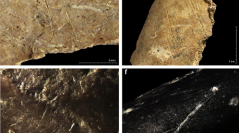

 Comptes Rendus Palevol
11 (4) - Pages 265-282
Comptes Rendus Palevol
11 (4) - Pages 265-282Within the framework of nutritional ecology, subsistence diversification is achieved by adding different species to a diet, but explanations for this diversification vary. In the Broad Spectrum Revolution approach, explanations include demographic, ecological, nutritional and technological factors, as well as the mobility of hunter-gatherer groups. The origin of small animal assemblages is a key issue underlying this debate, as these were an important food resource for several non-human predators (diurnal and nocturnal birds of prey and terrestrial carnivores). To establish the genesis of these accumulations, it is important to analyse the anatomical and age profiles of the animals, the bone breakage patterns and the bone surface modifications. With this aim, we present data from the Level IV faunal assemblage of Bolomor Cave (Valencia, Spain). Level IV, corresponding to MIS 5e, shows human use not only of small animals but also of large- and small-sized carnivores in addition to ungulates. Anthropogenic evidence includes cut-marks, intentional bone breakage, burning patterns and human tooth-marks. The utilisation of other less frequent animals could be related to a generalist human behaviour based on the exploitation of a broad range of prey, and could also be associated with an early diversification of the human diet in this locality. This study aims to provide data concerning human consumption of small prey, to establish the processing sequence both of large/medium and small animals and to contribute to the knowledge of human subsistence strategies in the European Middle Palaeolithic.
Subsistence strategies, Bolomor Cave, Level IV, Middle Palaeolithic, Iberian peninsula